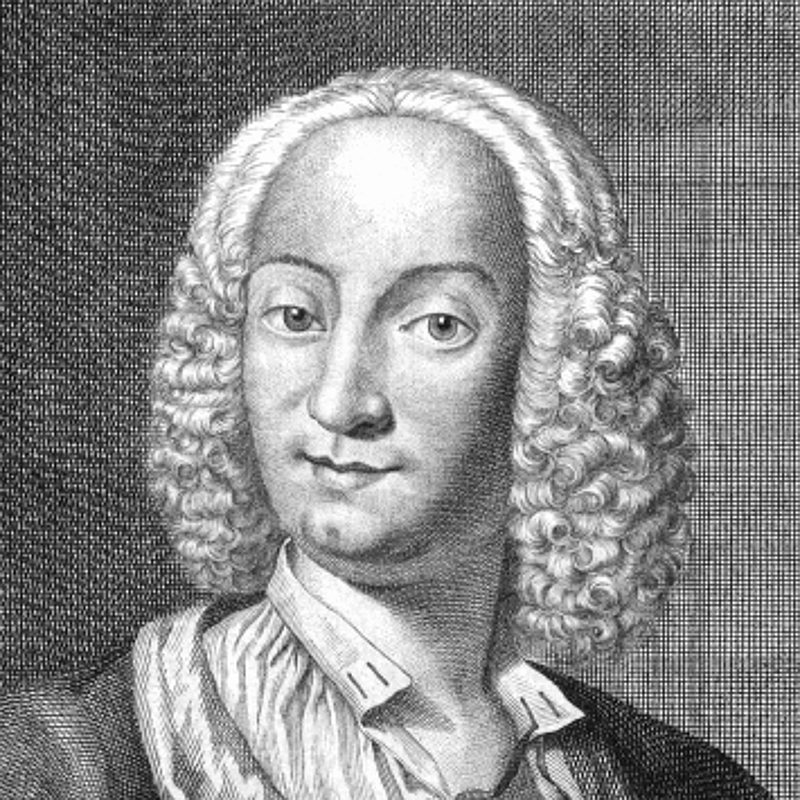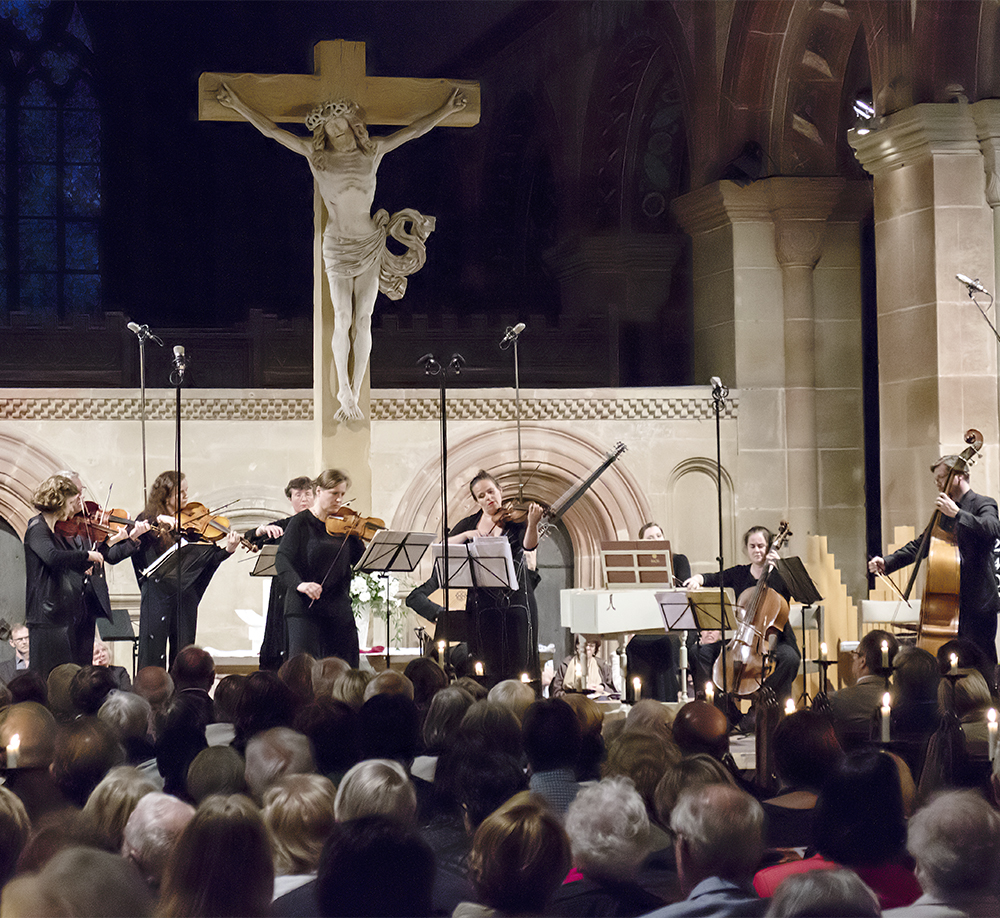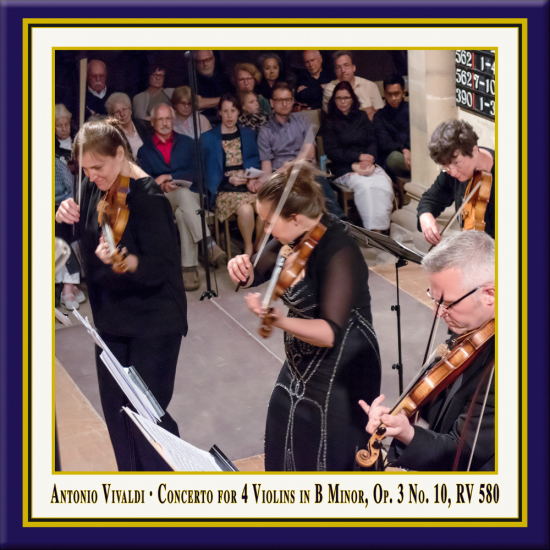Vivaldi: Concerto for 4 Violins in B Minor, Op. 3 No. 10, RV 580
Track
Concerto for 4 Violins in B Minor
Op. 3 No. 10, RV 580
From: "L'Estro Armonico",
performed according to the traditions of the time
by Lautten Compagney Berlin
A concert recordings from the church of the German
UNESCO World Heritage Site Maulbronn Monastery
HD Recording · DDD · Duration: 8:37
Digital Album [here: MP3/320kBit/sec.] · 3 Tracks · incl. Digital Booklet
MP3 Album
320 kBit/sec.



L
'estro armonico (the harmonic inspiration), Antonio Vivaldi's Op. 3, is a set of 12 concertos for stringed instruments, first published in Amsterdam in 1711. Vivaldi's Twelve Trio Sonatas, Op. 1, and Twelve Violin Sonatas, Op. 2, only contained sonatas, thus L'estro armonico was his first collection of concertos appearing in print. It was also the first time he chose a foreign publisher, Estienne Roger, instead of an Italian. Each concerto was printed in eight parts: four violins, two violas, cello and continuo. The continuo part was printed as a figured bass for violone and harpsichord. The concertos belong to the concerto a 7 format, that is: for each concerto there are seven independent parts. In each consecutive group of three concertos, the first is a concerto for four violins, the second for two violins, and the third a solo violin concerto. The cello gets solistic passages in several of the concertos for four and two violins, so that a few of the concertos conform to the traditional Roman concerto grosso format where a concertino of two violins and cello plays in contrast to a string orchestra. L'estro armonico pioneered orchestral unisono in concerto movements. Vivaldi composed a few concertos specifically for L'estro armonico, while other concertos of the set had been composed at an earlier date. Vivaldi scholar Michael Talbot described the set as "perhaps the most influential collection of instrumental music to appear during the whole of the eighteenth century". L'estro armonico (the harmonic inspiration) was published as Antonio Vivaldi's Op. 3 in Amsterdam in 1711. Vivaldi's Op. 1 and Op. 2 had only contained sonatas, thus L'estro armonico was his first collection of concertos appearing in print. It was also the first time Vivaldi chose a foreign publisher, Estienne Roger, instead of an Italian. Vivaldi composed a few concertos specifically for L'estro armonico, while other concertos of the set had been composed at an earlier date... From Wikipedia, The Free Encyclopedia


Soloist: Julia Schröder (Violin)
lautten compagney Berlin:
2nd Solo Violin & Concertmaster ~ Birgit Schnurpfeil
Violin ~ Matthias Hummel, Daniela Gubatz · Viola ~ Bettina Ihrig
Violin / Viola ~ Magdalena Schenk-Bader · Cello ~ Ulrike Becker
Double Bass ~ Alf Brauner · Harpsichord ~ Elina Albach
Lute ~ Johannes Gontarski
T
he lautten compagney Berlin is one of the most renowned and creative baroque instrument ensembles in Germany. Their concerts, under the artistic direction of Wolfgang Katschner, have fascinated audiences for three decades. With their infectious joy in performing and their innovative concepts, these 'early musicians' effortlessly translate the musical language of the Baroque to the present. The ensemble has received numerous awards for its exciting musical collaborations (2010 ECHO Klassik for 'Timeless', 2012 Rheingau Musik Preis). The lautten compagney is a regular guest at leading national and international concert halls and festivals, including Concertgebouw Amsterdam, Vienna Musikverein, Handel Festival Halle and Mosel Musikfestival. Twice a year, Wolfgang Katschner and the lautten compagney invite audiences to join them at AEQUINOX, a music festival for the equinox in Neuruppin, Brandenburg. Since 2014 the baroque musicians are also the ensemble in residence at the Festival Alter Musik Bernau.
The violinist Julia Schröder studied at the conservatory 'Gasteig' in Munich, at the Basel Music Academy and at the Schola Cantorum Basiliensis. Since 2004 Julia Schröder is the concert-mistress and director of the Basel Chamber Orchestra. Under her leadership the ensemble played in major concert halls in Europe such as the Vienna Musikverein, the Berlin Philharmonic, the Concertgebouw in Amsterdam, the Cité de la Musique in Paris and the Barbican Centre in London. In parallel she is a soloist accompanying artists such as Sol Gabetta, Andreas Scholl and Cecilia Bartoli. In 2010 she was called at the Freiburg Music Academy (D) to be a violin professor. She enjoys playing with Maurice Steger, Marcelo Nisinman, Gerard Wyss, Werner Güra and Christoph Berner. Julia Schröder is now a modern and universal musician, feeling comfortable in the world of modern violin as well as in the style of baroque play, while being also at ease in the improvisations of Jazz and she likes to play tango, too.
P
ublishing Authentic Classical Concerts entails for us capturing and recording outstanding performances and concerts for posterity. The performers, audience, opus and room enter into an intimate dialogue that in its form and expression, its atmosphere, is unique and unrepeatable. It is our aim, the philosophy of our house, to enable the listener to acutely experience every facet of this symbiosis, the intensity of the performance, so we record the concerts in direct 2-Track Stereo digital HD. The results are unparalleled interpretations of musical and literary works, simply - audiophile snapshots of permanent value. Flourishing culture, enthralling the audience and last but not least also you the listener, are the values we endeavor to document in our editions and series.
The concerts at the UNESCO World Heritage Maulbronn Monastery supply the ideal conditions for our aspirations. It is, above all, the atmosphere of the romantic, candle-lit arches, the magic of the monastery in its unadulterated sublime presence and tranquillity that impresses itself upon the performers and audience of these concerts. Renowned soloists and ensembles from the international arena repeatedly welcome the opportunity to appear here - enjoying the unparalleled acoustic and architectural beauty of this World Heritage Site, providing exquisite performances of secular and sacred music, documented by us in our Maulbronn Monastery Edition.
Andreas Otto Grimminger & Josef-Stefan Kindler, K&K Verlagsanstalt




